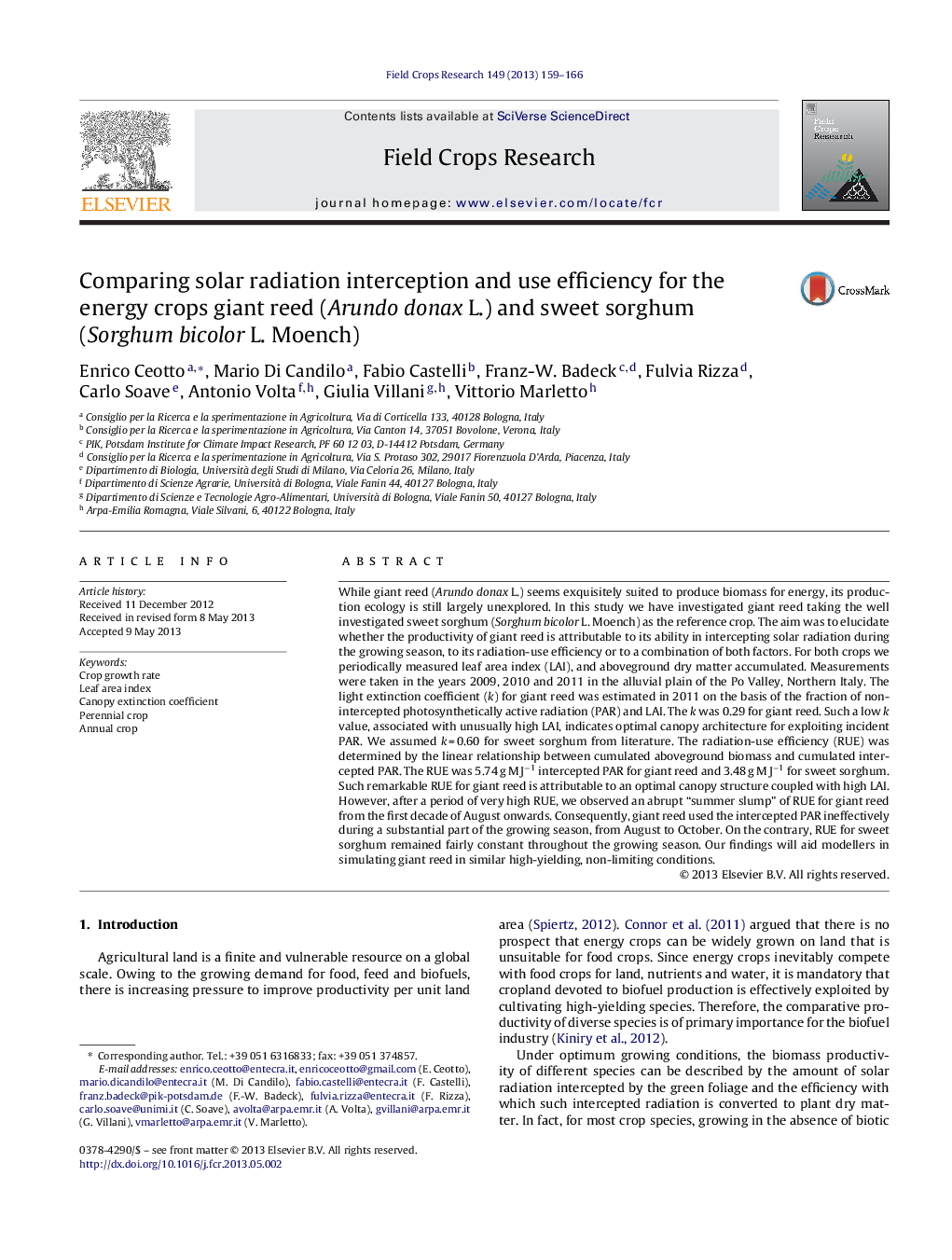| کد مقاله | کد نشریه | سال انتشار | مقاله انگلیسی | نسخه تمام متن |
|---|---|---|---|---|
| 6375257 | 1624714 | 2013 | 8 صفحه PDF | دانلود رایگان |
عنوان انگلیسی مقاله ISI
Comparing solar radiation interception and use efficiency for the energy crops giant reed (Arundo donax L.) and sweet sorghum (Sorghum bicolor L. Moench)
دانلود مقاله + سفارش ترجمه
دانلود مقاله ISI انگلیسی
رایگان برای ایرانیان
کلمات کلیدی
موضوعات مرتبط
علوم زیستی و بیوفناوری
علوم کشاورزی و بیولوژیک
علوم زراعت و اصلاح نباتات
پیش نمایش صفحه اول مقاله

چکیده انگلیسی
While giant reed (Arundo donax L.) seems exquisitely suited to produce biomass for energy, its production ecology is still largely unexplored. In this study we have investigated giant reed taking the well investigated sweet sorghum (Sorghum bicolor L. Moench) as the reference crop. The aim was to elucidate whether the productivity of giant reed is attributable to its ability in intercepting solar radiation during the growing season, to its radiation-use efficiency or to a combination of both factors. For both crops we periodically measured leaf area index (LAI), and aboveground dry matter accumulated. Measurements were taken in the years 2009, 2010 and 2011 in the alluvial plain of the Po Valley, Northern Italy. The light extinction coefficient (k) for giant reed was estimated in 2011 on the basis of the fraction of non-intercepted photosynthetically active radiation (PAR) and LAI. The k was 0.29 for giant reed. Such a low k value, associated with unusually high LAI, indicates optimal canopy architecture for exploiting incident PAR. We assumed k = 0.60 for sweet sorghum from literature. The radiation-use efficiency (RUE) was determined by the linear relationship between cumulated aboveground biomass and cumulated intercepted PAR. The RUE was 5.74 g M Jâ1 intercepted PAR for giant reed and 3.48 g M Jâ1 for sweet sorghum. Such remarkable RUE for giant reed is attributable to an optimal canopy structure coupled with high LAI. However, after a period of very high RUE, we observed an abrupt “summer slump” of RUE for giant reed from the first decade of August onwards. Consequently, giant reed used the intercepted PAR ineffectively during a substantial part of the growing season, from August to October. On the contrary, RUE for sweet sorghum remained fairly constant throughout the growing season. Our findings will aid modellers in simulating giant reed in similar high-yielding, non-limiting conditions.
ناشر
Database: Elsevier - ScienceDirect (ساینس دایرکت)
Journal: Field Crops Research - Volume 149, 1 August 2013, Pages 159-166
Journal: Field Crops Research - Volume 149, 1 August 2013, Pages 159-166
نویسندگان
Enrico Ceotto, Mario Di Candilo, Fabio Castelli, Franz-W. Badeck, Fulvia Rizza, Carlo Soave, Antonio Volta, Giulia Villani, Vittorio Marletto,